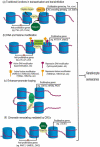ΔNp63α-mediated epigenetic regulation in keratinocyte senescence
- PMID: 36760085
- PMCID: PMC9980457
- DOI: 10.1080/15592294.2023.2173931
ΔNp63α-mediated epigenetic regulation in keratinocyte senescence
Abstract
Keratinocyte senescence contributes to skin ageing and epidermal dysfunction. According to the existing knowledge, the transcription factor ΔNp63α plays pivotal roles in differentiation and proliferation of keratinocytes. It is traditionally accepted that ΔNp63α exerts its functions via binding to promoter regions to activate or repress gene transcription. However, accumulating evidence demonstrates that ΔNp63α can bind to elements away from promoter regions of its target genes, mediating epigenetic regulation. On the other hand, several epigenetic alterations, including DNA methylation, histone modification and variation, chromatin remodelling, as well as enhancer-promoter looping, are found to be related to cell senescence. To systematically elucidate how ΔNp63α affects keratinocyte senescence via epigenetic regulation, we comprehensively compiled the literatures on the roles of ΔNp63α in keratinocyte senescence, epigenetics in cellular senescence, and the relation between ΔNp63α-mediated epigenetic regulation and keratinocyte senescence. Based on the published data, we conclude that ΔNp63α mediates epigenetic regulation via multiple mechanisms: recruiting epigenetic enzymes to modify DNA or histones, coordinating chromatin remodelling complexes (CRCs) or regulating their expression, and mediating enhancer-promoter looping. Consequently, the expression of genes related to cell cycle is modulated, and proliferation of keratinocytes and renewal of stem cells are maintained, by ΔNp63α. During skin inflammaging, the decline of ΔNp63α may lead to epigenetic dysregulation, resultantly deteriorating keratinocyte senescence.
Keywords: Keratinocyte; cell proliferation; cellular senescence; chromatin remodeling; epigenetic regulation; skin aging; ΔNp63α.
Conflict of interest statement
The authors declare that they have no known competing financial interests or personal relationships that could have appeared to influence the work reported in this paper.
Figures


Similar articles
-
TP63 links chromatin remodeling and enhancer reprogramming to epidermal differentiation and squamous cell carcinoma development.Cell Mol Life Sci. 2020 Nov;77(21):4325-4346. doi: 10.1007/s00018-020-03539-2. Epub 2020 May 23. Cell Mol Life Sci. 2020. PMID: 32447427 Free PMC article. Review.
-
Dual regulation of TERT activity through transcription and splicing by DeltaNP63alpha.Aging (Albany NY). 2008 Dec 9;1(1):58-67. doi: 10.18632/aging.100003. Aging (Albany NY). 2008. PMID: 20157588 Free PMC article.
-
ΔNp63α is a super enhancer-enriched master factor controlling the basal-to-luminal differentiation transcriptional program and gene regulatory networks in nasopharyngeal carcinoma.Carcinogenesis. 2020 Sep 24;41(9):1282-1293. doi: 10.1093/carcin/bgz203. Carcinogenesis. 2020. PMID: 31826234
-
Epigenetic regulation in cell senescence.J Mol Med (Berl). 2017 Dec;95(12):1257-1268. doi: 10.1007/s00109-017-1581-x. Epub 2017 Sep 8. J Mol Med (Berl). 2017. PMID: 28887637 Review.
-
Particulate matter-induced senescence of skin keratinocytes involves oxidative stress-dependent epigenetic modifications.Exp Mol Med. 2019 Sep 24;51(9):1-14. doi: 10.1038/s12276-019-0305-4. Exp Mol Med. 2019. PMID: 31551408 Free PMC article.
Cited by
-
YAP/TAZ Signalling Controls Epidermal Keratinocyte Fate.Int J Mol Sci. 2024 Nov 30;25(23):12903. doi: 10.3390/ijms252312903. Int J Mol Sci. 2024. PMID: 39684613 Free PMC article. Review.
-
Let-7 family regulates HaCaT cell proliferation and apoptosis via the ΔNp63/PI3K/AKT pathway.Open Med (Wars). 2024 Mar 23;19(1):20240925. doi: 10.1515/med-2024-0925. eCollection 2024. Open Med (Wars). 2024. PMID: 38584846 Free PMC article.
-
Unraveling the Epigenetic Tapestry: Decoding the Impact of Epigenetic Modifications in Hidradenitis Suppurativa Pathogenesis.Genes (Basel). 2023 Dec 26;15(1):38. doi: 10.3390/genes15010038. Genes (Basel). 2023. PMID: 38254928 Free PMC article. Review.
-
Nucleosome binding by TP53, TP63, and TP73 is determined by the composition, accessibility, and helical orientation of their binding sites.Genome Res. 2025 Mar 18;35(3):404-416. doi: 10.1101/gr.279541.124. Genome Res. 2025. PMID: 39929723
-
Trophoblast Extracellular Vesicles as Modulators of Keratinocyte Stress Response and Senescence.Life (Basel). 2025 Jun 5;15(6):918. doi: 10.3390/life15060918. Life (Basel). 2025. PMID: 40566570 Free PMC article.
References
Publication types
MeSH terms
Substances
LinkOut - more resources
Full Text Sources
